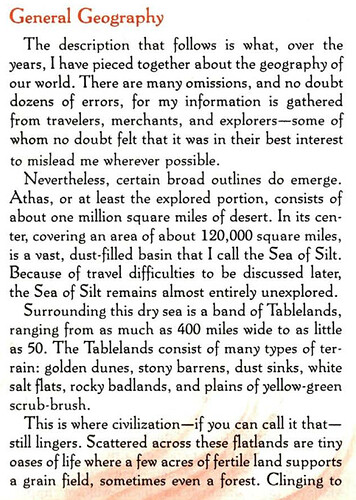Was the Wanderer always meant to be an unreliable narrator or did they forget/change a lot of stuff from the initial Wanderer’s Journal?
When I first read the Wanderer’s Journal many years ago, I was blown away by the setting. It was totally unlike any other fantasy world going around at the time. It still remains by far my favourite D&D world setting and right up there in terms of my favourite fantasy world of all time.
Rereading it again recently, I was struck by just how much was later changed in later supplements. Not just by the addition of things like the halflings as the first race, the cleansing war etc, but a whole host of things.
I actually prefer the world as is presented in the initial Wanderer’s Journal, with all its mysteries and implications. Not everything that came later is bad but a lot just doesn’t seem to mesh with what was presented at first.
So is it a case that they were deliberately giving misinformation at first (and if so why?) or did they just forget or change it later on?
Even the geography changed - right at the start it is described as a million square miles of explored land (about a quarter of the size of Europe) completely encircled by the Ringing Mountains, with a Poland sized Sea of Silt in the middle. The Tablelands occupies the narrow band of land between the Sea and the Mountains, with the Tyr Region being only a small part of that land, with the rest of it being described as much the same as the Tyr region, including that it is occupied.
The description of Draj references it to trading with ‘some cities to the north’, while the entry on North and South Ledopolus states that they are trying to build their bridge to shorten the caravan route from Gulg to Balic and ‘other cities south of the Tyr Region.’
And then a lot of that changed. The Ringing Mountains disappeared in places, all the explored land was suddenly unexplored, the cities in the south vanished and those in the north turned out to be just two, Kurn (all but abandoned as far as everyone else knows) and Eldaarich, neither of which do much trade. (If there were to be only two cities, they really should have said a couple as some cities does have some implications for more than two.) I’ve always liked the idea of their being more city-states out there, little known and hard to get to due to the difficulties of traveling far.
Even the nature of the Sorcerer Kings was changed. A couple of times it is said that almost all are defilers, which has interesting implications. (There is Oronis but the Wanderer didn’t know of him at the time of his first Journal.) Right at the very start of the Journal it also says that the SK squander their armies on ‘raising gaudy palaces and garish tombs.’ You don’t build tombs if you aren’t expecting to die. The Wanderer seems to think they are centuries old, possibly a thousand, while the city-states are thousands of years old, and that while none have died in his, his father’s and his father’s fathers lifetime, that they can die, as evidenced by two abandoned city-states.
There is also his theory given in the Draj entry, that Tectuktitlay started as a young and weak Defiler, led a small band of followers to the place where Draj was founded and as it prospered he became a Sorcerer-King.
The way it is written, it gives the implication that 1) you could become a sorcerer-king and 2) sorcerer-kings were not immortal but could die, which is why they were building tombs for themselves. That sounds a far more interesting world than what was later to be given; ie the Champions, in that old SKs could die and new ones rise up to replace them. And trying to break into the tomb of a dead SK would be rather interesting.
Oh, yeah, and the Dragon as well. Right at the very start it speaks of it despoiling entire cities, which is kind of a bad thing to be doing if it relies on the cities to be providing it with a tribute of slaves (but that isn’t mentioned in the initial Journal.) It is described as pretty much just wandering around feeding its insatiable appetite on whatever it comes across - merchant caravans, herders and their herds, villages, city-states, and the SKs are named as babes compared to the power of the Dragon.
There are a number of other things as well, such as populations and army sizes - Urik alone is mentioned as having 10,000 slave-soldiers and a 1,000 half-giant soldiers, not counting merchant and noble house soldiers. To feasibly support such a large army would require quite a larger population than given. And talk of how in times of famine the city-states would raid each other for food and slaves, which sound a lot like Celtic cattle-raids, a concept that isn’t raised again but would make a great plot for an adventure.
There is more but I’ve gone on longer than I expected. The point is, if they already did have the back history worked out, why go to the effort of presenting a world rather different than what later came out and a world, to my mind, that was actually better than what we later got.
